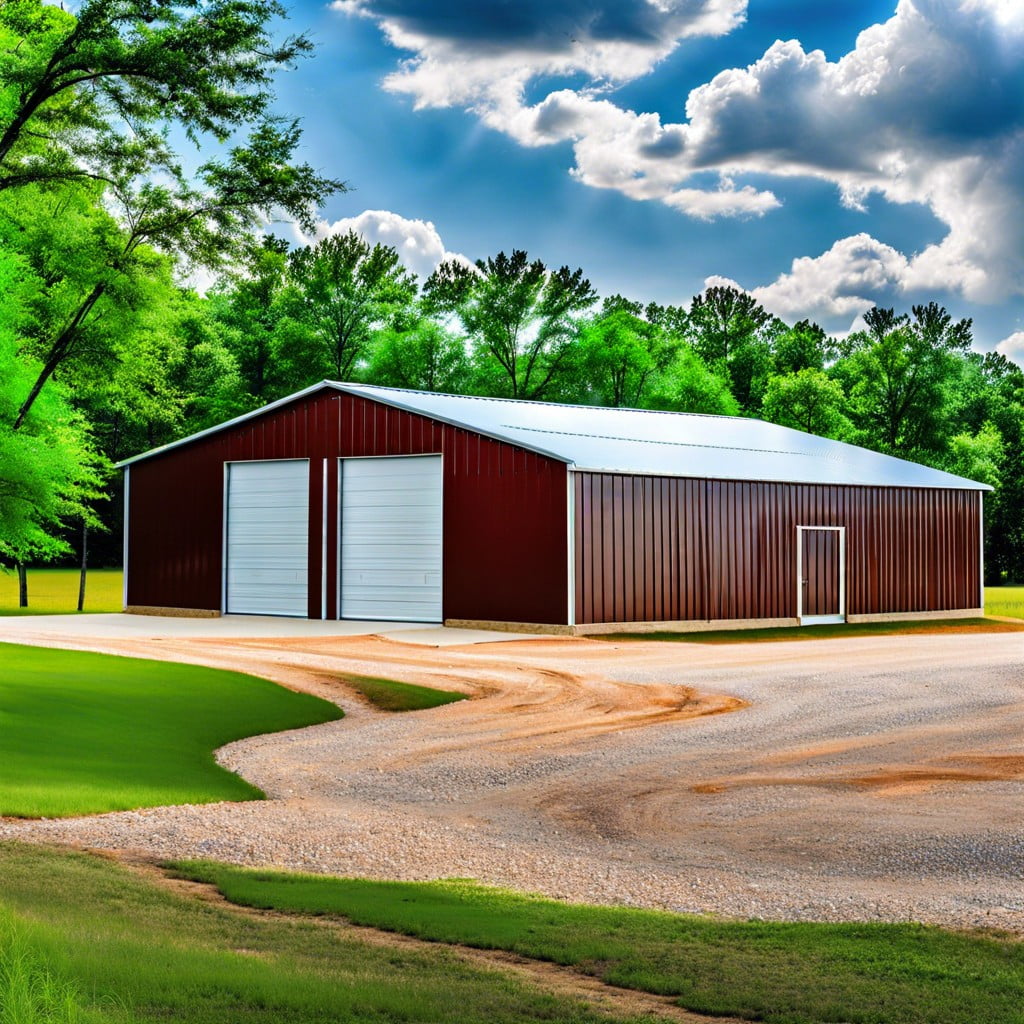This article provides a comprehensive overview of steel buildings in Arkansas, including benefits, common uses, and procurement processes.
Key takeaways:
- Steel buildings in Arkansas offer durability and flexibility in design.
- Adherence to local building codes is crucial for a smooth construction process.
- Factors such as material costs, labor, and design complexity affect the overall cost of steel structures.
- The installation process involves site inspection, foundation laying, and secure connections.
- Future trends in metal building construction in Arkansas include eco-friendly designs, smart technology integration, customization, and prefabricated components.
Benefits of Steel Buildings in Arkansas

Arkansas experiences a range of weather patterns, from hot, humid summers to icy winters. Steel buildings hold up well against such diverse conditions, offering durability and reduced maintenance needs. Their resistance to fire, pests, and mold is especially valuable in Arkansas’s occasionally harsh climate.
These structures also provide flexibility in design. This adaptability is perfect for a variety of uses, whether for agricultural storage in the Delta, commercial enterprises in Little Rock, or residential garages in the Ozarks. With the ability to customize dimensions and features, steel buildings can meet specific needs efficiently.
Additionally, sustainability is a key advantage. Steel is one of the most recyclable materials in the world, promoting a greener construction approach which is increasingly important to environmentally conscious consumers. Energy efficiency is another factor, as modern steel buildings often include insulated panels that help regulate indoor temperatures, cutting down on heating and cooling costs.
Legal and Building Codes for Steel Buildings in Arkansas
Navigating local building codes is crucial for any construction project, including erecting steel buildings. In Arkansas, adherence to specific regulations ensures smooth project advancement without legal hitches. Here are key points to consider:
Firstly, confirm zoning requirements. Different areas in Arkansas have varied zoning laws that dictate the types of buildings allowed. Consulting with local zoning offices can save you from future complications.
Secondly, understand the state’s building codes. Arkansas adheres to several international codes but may have amendments specific to the state’s climate and topography. These codes cover safety measures, environmental considerations, and energy efficiency requirements.
Lastly, always obtain the necessary permits before starting construction. This typically involves submitting your building plans for approval by local authorities. Skipping this step can lead to fines and forced alterations to your project.
Remember, staying informed and complying with all legal requirements facilitates a smoother and more efficient building process.
Cost Factors of Building Steel Structures in Arkansas
The price of building a steel structure can fluctuate based on several factors specific to Arkansas. First, material costs can vary, especially with global market changes impacting steel prices. It’s wise to get current quotes from suppliers to budget effectively.
Labor costs are another consideration. The skill level and availability of construction workers in Arkansas can influence wages. Urban areas like Little Rock may have higher labor rates compared to rural regions.
Transportation and delivery of materials also play a role. If your site is remote, expect higher charges for shipping large steel panels and beams.
Lastly, design complexity affects the budget. A more intricate architectural design requires additional resources and time, pushing up costs.
Considering these factors early in your planning phase can lead to more precise budgeting and smoother project execution.
Installation Process for Metal Buildings in Arkansas
To begin, a site inspection ensures the land is flat and stable, avoiding future stability issues. Following site approval, foundations are laid. Choices include concrete slabs, piers, or footings, each aligned with specific building needs and soil conditions.
Next, the steel frame is erected. This involves assembling the primary columns and beams, bolted together for strength. Wall panels and roofing systems are then attached to this frame. Ensuring all connections are secure is crucial for the structural integrity.
Throughout the process, adherence to Arkansas’s specific building codes and regulations is mandatory. Local inspectors usually visit to confirm compliance at several stages, which helps streamline the process and prevent project delays.
Professional installation teams often handle the entire process from foundation to finishing touches, including insulation and electrical setups. This turnkey solution minimizes stress for the owner and guarantees all aspects meet the required standards.
Future Trends in Metal Building Construction in Arkansas
As technology evolves, so does the construction of metal buildings in Arkansas. One of the most significant shifts is toward eco-friendly designs. Builders are increasingly incorporating energy-efficient materials and solar panels to reduce environmental impact and operational costs.
Another upcoming trend is the integration of smart technology. Buildings are being equipped with advanced systems for automation, including HVAC, lighting, and security, all controllable via smartphones, enhancing convenience and efficiency.
Customization continues to grow in popularity, with more clients preferring designs that reflect their specific needs and aesthetic preferences. This adaptability extends to both commercial and residential properties, ensuring a wide range of applications.
Finally, the use of prefabricated components is on the rise. This method streamlines the construction process, significantly reduces onsite labor, and cuts down project timelines, which is a massive advantage in today’s fast-paced market.
Related Reading:
- Metal Buildings Arkansas: Your Essential Buying Guide
- General Steel Building Prices: Understanding Costs and Factors
- Warehouse Building Essentials: Types, Costs and Construction Tips
- 100×200 Steel Building Cost: Factors, Estimates & Savings Tips
- Gensteel Prices Buying Guide: Understand Costs and Value Before You Purchase